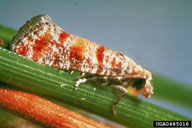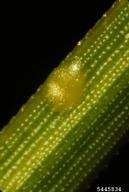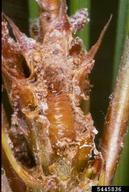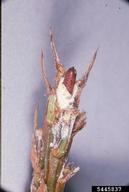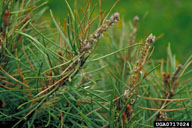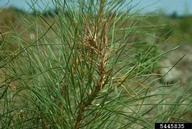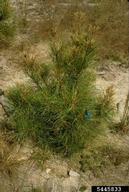Nantucket pine tip moth
Rhyacionia frustrana (Comstock) (Lepidoptera: Tortricidae)
Orientation to pest
Nantucket pine tip moth, Rhyacionia frustrana (Comstock), is a native shoot-boring tortricid associated with pines in the eastern United States. There is a similar insect, found in Nebraska attacking pines in plantations, that was formerly thought to be a subspecies of R. frustrana but later was recognized as its own species, Rhyacionia bushnelli Miller. Larvae of Nantucket pine tip moth bore into and kill leaders of pines, both reducing overall growth in wood volume and deforming the tree. The species is a pest of various southern pines in plantations. Some species such as shortleaf (Pinus echinata Miller) and loblolly (Pinus taeda L.) pines are severely affected. The proportion of tips infested by this pest decreases after trees reach 3-4 meters in height.
Hosts commonly attacked
In North America, Nantucket pine tip moth attacks several southern pines in plantations, especially shortleaf (P. echinata) and loblolly (P. taeda) pines. In New England, pitch pine (Pinus rigida Miller) is a favorite host in pine barrens.
Distribution
Nantucket pine tip moth occurs in the United States from eastern Texas north to Missouri, east to Florida and north to Massachusetts. There is also an isolated, invasive population in southern California.
Images of Nantucket pine tip moth
| Figure 1. Adult of Nantucket pine tip moth, Rhyacionia frustrana | Figure 2. Egg of Nantucket pine tip moth | Figure 3. Larva of Nantucket pine tip moth | Figure 4. Pupa of Nantucket pine tip moth |
| Figure 5. Dead tips caused by feeding of Nantucket pine tip moth | Figure 6. Stunting seedling tree due to tip death from Nantucket pine tip moth feeding |
Important biological control agents related to this pest species
Many studies have described the parasitoids that can be reared from larvae and pupae of Nantucket pine tip moth. Of the various larval parasitoids noted, the species that are consistently of greatest importance in nearly all studies have been, in order of importance, the ichneumonid Campoplex frustranae Cushman, the tachinid Lixophaga mediocris Aldrich, and the eurytomid Eurytoma pini Bugbee (see Van Driesche et al. 1996 for details on natural enemies of this moth). Introduction of C. frustranae to California greatly reduced the density of the invasive population of this species found in that area.
Web links for information on Nantucket pine tip moth
- Featured Creature Fact Sheet | University of Florida and FDACS
- Forest Insect & Disease Leaflet 70 | USDA Forest Service
Articles
- Van Driesche, R.G., S. Healy, and R. C. Reardon. 1996. Biological Control of Arthropod Pests of the Northeastern and North Central Forests in the United States: A review and recommendation. FHTET 96-19, December 1996, USDA Forest Service, Morgantown, see: http://www.forestpestbiocontrol.info/fact_sheets/documents/arthropodpestsnortheastern_northcentral.pdf.
- McCravy, K. W. and C. W. Berisford. 2001. Effects of vegetation control on parasitoids of the Nantucket pine tip moth, Rhyacionia frustrana (Lepidoptera: Tortricidae). Florida Entomologist 84: 282-287.
- DeBarr, G. L., J. W. Brewer, R. S. Cameron, and C. W. Berisford. 2002. Nantucket pine tip moth, Rhyacionia frustrana, lures and traps: what is the optimum combination? The Nantucket pine tip moth: old problems, new research. Proceedings of an Informal Conference, The Entomological Society of America, Annual Meeting, Atlanta, Georgia, USA, 12-16 December 1999, pp. 56-68. In: Berisford, C. W. and D. M. Grosman (eds.). General Technical Report SRS-51, Southern Research Station, Southern Research Station, USDA Forest Service, Ashville, North Carolina.
